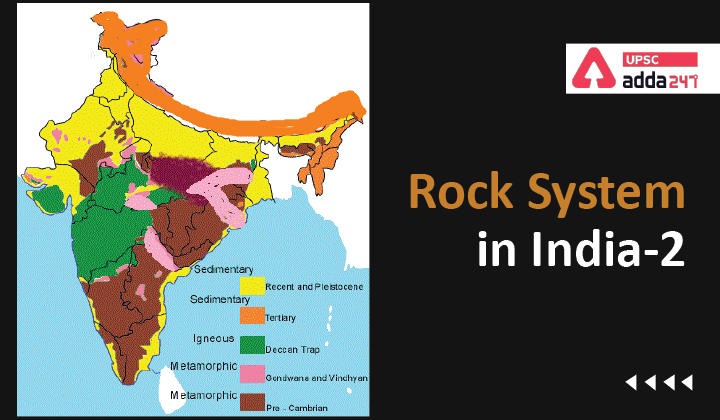Table of Contents
Rock System in India
In the previous article, we have discussed about the Archaean Rock System and the Purana Rock System. We will discuss the next two rock systems in this article.
Dravidian rock system
- The Paleozoic rock formation is known as Dravidian systems in India.
- These rock systems were formed during the Paleozoic era i.e., 600-300 million years ago.
- It also known as the carboniferous rocks system due to high quality coal formation in the world.
- These rocks are mostly found in the extra-Peninsular regions of the Himalayas and the Gangetic plain and are very little in the Peninsular shield.
- It is the period when Pangaea was broken, and the Tethys Sea came into existence.
- This period also marks the beginning of life on earth surface.
- Dravidian period was the beginning of coal formations; however, these formations were not found abundantly in India.
Aryan rock system
- The beginning of Upper carboniferous period is known as the Aryan Group. The Aryan group of rock formation is further classified in following groups.
- Upper Paleozoic Era
- Mesozoic Era
- Cenozoic Era
- Neozoic Era
Salient features of Aryan formations
- Himalayan region was occupied by a vast geosyncline which was connected to the Tethys Sea.
- The area of Kashmir Himalayas witnessed violent volcanic activity.
- The upper continent of Gondwanaland developed fissures and its broken parts started drifting away from each other.
- The Indian subcontinent drifted towards north and north-east to collide with the Eurasian Plate.
- The Tertiary Mountain building gave birth of Himalayas.
- Evolution and spread of man in different parts of the world.
Gondwana system
- The Gondwana rock system is named after the Gond tribe (indigenous people mainly found in the Telangana and Andhra Pradesh regions).
- This system contains huge carbon deposits within them, which makes them the largest source of coal in India, containing up to 98 percent of our coal deposits.
- The Gondwana rocks are mainly found in Ranigunj, Jharia regions of Jharkhand, Damodar valley, Pench valley in Chhattisgarh and Madhya Pradesh, Godavari valley in Telangana and the Rajmahal hills of West Bengal.
Deccan trap
- Daccan Trap was formed when the Indian plate came over the Reunion hotspot in the Indian Ocean while travelling north towards the Eurasian plate, after breaking up from the Gondwana plate.
- The continuous outpouring of magma, from the fissures over the Indian plate led to the formation of a layered structure called the Deccan Traps.
- These are formed by the flow of magma over the solidified rock systems/cooled magma in layers.
- This structure is made up of basalt and dolorite rocks.
- These rocks are very hard, and their weathering has resulted in the formation of the black soil.
Tertiary system
- These rocks belong to the Cenozoic era, formed around 60 million years ago.
- This system is characterised by two events:
- The final breaking up the old Gondwana land, and
- The upliftment of Tethys geosynclines or Himalayas.
- The Himalayan Mountain range has developed in the following period:
- The Great Himalayas were formed during the Oligocene period’
- The Lesser Himalayas were formed during the Miocene period.
- Shiwaliks were formed during the Pliocene and Upper Pliocene periods.
- The rocks of this era have shown much valuable resources of petroleum and coal.
- The Tertiary Succession are fully spread over the Bengal and Ganges delta, East coast and Andaman Islands.
- The Tertiary’s, in India, are also called as Marine Tertiary’s.
Quaternary system
- The Quaternary is named proposed for very recent deposits, which contains fossils of species with living representatives.
- The alluvium which is found in the Indo-Gangetic plain belong to this era.
- It also includes all the recent alluvial deposits of Indo-Gangetic plains in the northern parts of India.
- Bhangar, khaddar, karewas were formed are part of this rock system.
Geography notes for UPSC





 TSPSC Group 1 Question Paper 2024, Downl...
TSPSC Group 1 Question Paper 2024, Downl...
 TSPSC Group 1 Answer key 2024 Out, Downl...
TSPSC Group 1 Answer key 2024 Out, Downl...
 UPSC Prelims 2024 Question Paper, Downlo...
UPSC Prelims 2024 Question Paper, Downlo...
